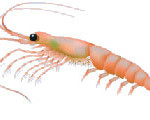
Brachiopods mimic clams in appearance, but are anatomically quite different and are not related to the bivalve mollusc. They are filter feeding marine animals belonging to their own phylum (Brachiopoda) of the animal kingdom. Modern brachiopods occupy a variety of seabed habitats ranging from the Tropics to cold Polar waters, especially Antarctic waters. They are lophophorates, one of the major groups within the animal kingdom and so are related to the Bryozoa and Phoronida. In turn, the Lophotrochozoa belong to a larger group within the Kingdom Animalia called the Bilateria, so named because they are bilaterally symmetrical with a left and a right side to their bodies.
They look like clams, at least in the sense that they have two shells. One shell – or valve – is the pedical (foot or ventral) valve and is used by the brachiopod to attach itself to a substrate. The other shell is the brachial or dorsal valve, which generally has a rounded elevated section through the midline. They are small animals with the largest living species having a shell length of about 10 cm and most species being much smaller than this.
Brachiopods are also commonly known as lampshells because the shape of the ventral valve of some Mediterranean species is thought to resemble ancient Greek and Roman oil lamps.
Although they seem rare in today’s seas, there are about 300 living species of brachiopods and are actually fairly common, occurring in all oceans. However, because of their preference for very cold-water habitats, either in Polar regions or at great depths in the ocean, they are not commonly encountered. Although no longer numerous, they were once one of the most abundant forms of life.
Today Brachiopods are excellent indicators of a healthy, diverse environment.







Social Profiles